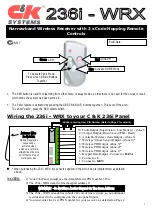
PTRLNV/4 & RXRLNV/4
ELETTRONICA
21
/ 34
User Manual
Rev. 1.0 - 09/06/10
F1 :2350.000MHz
Pwr: ON
Mod: x 1
PgD: 50 %
PgR: 50 %
IIC: 1
Exit
Menu 4
F1
Regulation of set up frequency. After having set a new
frequency value, press the ENCODER to confirm the choice.
The transmitter will release from the current frequency (the
LOCK LED turns off) and it will latch onto the new operating
frequency (LOCK turns back on). Instead, if you let the
timeout go by, the frequency will remain set at the previous
value.
Pwr
Enables (On) or disables (Off) the power supply of the
transmitter.
Mod
Display modality of the modulation selectable between x1
and x10. The indication of the instantaneous deviation is
multiplied by a factor 10 in the x10 mode, so the hatched
indicator on the predefined menu will coincide with the 7.5
kHz value instead of 75 kHz. This display mode is useful
when you want to view low deviation levels such as, for
example, those due to the pilot tone or to the subcarriers.
PgD
Regulation of the Power Good threshold relative to the
forward power. The percentage value of Power Good is
referred to the nominal power of the machine, that is 5W
for 1.6GHz version or 2/5W for 2.4GHz, not to the supplied
forward power. If a value equal to 50% is setted. The Power
Good function is a control and alarm function on the supplied
power. When the output power fall under the threshold value
of Power Good set, the machine modifies the pin state [7] of
“Remote” DB15 connector on the rear panel.
PgR
Regulation of the Power Good threshold relative to the
forward power. The percentage value of Power Good is
referred to the nominal power of the machine not to the
supplied forward power.
Note:
This alarm does not have effect on any output signal
on the DB15 “Remote” connector, placed on the rear panel
of the equipment, and it works only in presence of systems
equipped of telemetry.
IIC
Regulation of the I
2
C address. The I
2
C network address is
important when the transmitter is connected to a company’s
transmission system that envisages use of this protocol. We
recommend you do not modify it without a good reason.
















































